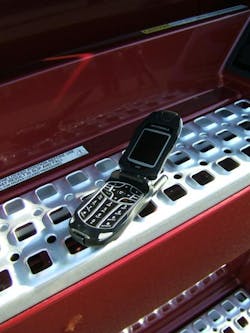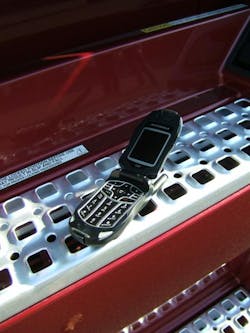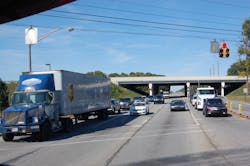Seeking technological cures for distracted driving
And it’s a rule with some steep penalties to consider. For example, under the new ban, individual drivers face civil penalties up to $2,750, while employers can be held liable and fined up to $11,000 per infraction committed if drivers carrying out company business or otherwise acting on the employer’s behalf if they are caught using a hand-held mobile device while behind the wheel.
[You can read the complete text of the new rule by clicking here.]
Yet the question remains: how does a fleet ensure that its drivers are obeying such rules? That is precisely a gap many believe technology is ideally suited to fill.
Take a package developed by Cellcontrol for example. Chuck Cox, Cellcontrol’s Sr. VP and COO, noted that his company’s cell phone blocking software works by tapping into a vehicle’s onboard computer in order to determine when it is in motion.
Once the vehicle is determined to be moving, it blocks the use of a driver’s cell phone or laptop based on the companies distracted driving policy – preventing phone calls, texting, e-mail, Web, push-to-talk and other such “distracting” features.
However, he stresses that calling 911 is a function always allowed to the driver, while all incoming texts, emails and calls are stored for review since they cannot be accessed while the vehicle is moving.“There’s always three phases to dealing with issues like the cell phone ban,” Cox says. “First there must be an awareness of the issue, followed by a fleet taking ownership of the issue. Finally, there’s the resolution phase, where solutions for the issues are deployed.”
To attack this problem from a similar angle, cell phone provider Sprint and Aegis Mobility hare teaming up offer the FleetSafer – software for mobile that also auto-activates once the vehicle is in motion, preventing texting, e-mailing and browsing, yet still enabling hands-free phone conversations.
“Distracted driving is a critical issue,” explains John Dupree, senior VP-business sales for Sprint. “Technology can play a huge role in helping businesses reinforce policies, minimize risk and make it easy for their employees to focus on driving.”Yet Robert Armstrong, senior manager for North American enterprise vertical marketing at Motorola Solutions Inc., would have fleets keep in mind something very important as they start coming to grips with this new cell phone ban: that compliance with the rule needs to be viewed from a broad safety perspective.
“There are a few different approaches to ensuring not only compliance with the regulation itself, but also successful adoption of best-practices for driver safety – and a technology-only solution isn’t the only answer, nor is it the best answer,” he stresses.
“With any successful change management, there are always three pieces to the equation which need to be considered holistically: people, process, and technology,” Armstrong emphasizes. With that in mind, he offers some of the following groups of questions fleets should ask regarding each of those three areas:
People
- Do your drivers know why this regulation is important, and do they believe it is necessary?
- How does your management team educate, train, foster and encourage a positive culture which embraces the change?
- Are your customers aware of the need for you to change, and aware of how it will impact them? Is this an opportunity for you to differentiate your company in their eyes?
Process
- What changes are you asking your drivers to make during their shift in order to ensure compliance and safety, whether before, during, or after drive-time?
- How will this impact your driver’s workflow – positively or negatively? Do current processes by non-driver personnel need to change to accommodate this new workflow, or do customer expectations need to be reset?
- How might you need to change your performance measures or metrics in order to accommodate and reinforce the change?
Technology
- How can you use the technology within the cab of the truck, or carried by drivers, to reinforce the “people” and “process” pillars of your change management strategy? For example, do you regularly push training videos or reminders to your drivers before they begin drive-time to reinforce the new way to do things?
- What testing periods and feedback opportunities will you give your drivers to ensure they can properly evaluate the various technical options, to ensure they can be active participants in selecting the solution that best meets their needs and preferences?
- How will this technology be funded? Can you fund it completely using capital funds, or would a recurring operational expense be preferred, or a mix of the two?
The ultimate answers to those questions will vary by fleet, Armstrong says, but universally the easiest path to ensuring that non-compliant technology use does not occur is to always take a "holistic" look at the issue across people, process, and technology.
“When that happens, it’s actually not that hard to achieve the desired compliance,” he says.
Good stuff to keep in mind, as trucking will be dealing with distracted driving regulations for some time to come.



